Evaluating Decision-Making in Australian Educational Leadership
VerifiedAdded on 2023/03/31
|13
|3293
|198
Essay
AI Summary
This essay provides an analysis of leadership and decision-making within the Australian education sector. It examines the complexities of decision-making processes, the involvement of various stakeholders, and the strengths and weaknesses of the current system. The essay delves into the perspectives of teachers and other stakeholders regarding their participation in decision-making, highlighting instances of both effective collaboration and areas where improvements are needed. The discussion includes an evaluation of curriculum review processes and the role of government task forces. The essay concludes by emphasizing the importance of balanced and fair decision-making practices for the continued success of the Australian education system and suggests that Desklib offers valuable resources for students seeking to deepen their understanding of these topics.

Running head:LEADERSHIP AND TEAM BUILDING
Name:
Institution:
Date:
Name:
Institution:
Date:
Paraphrase This Document
Need a fresh take? Get an instant paraphrase of this document with our AI Paraphraser
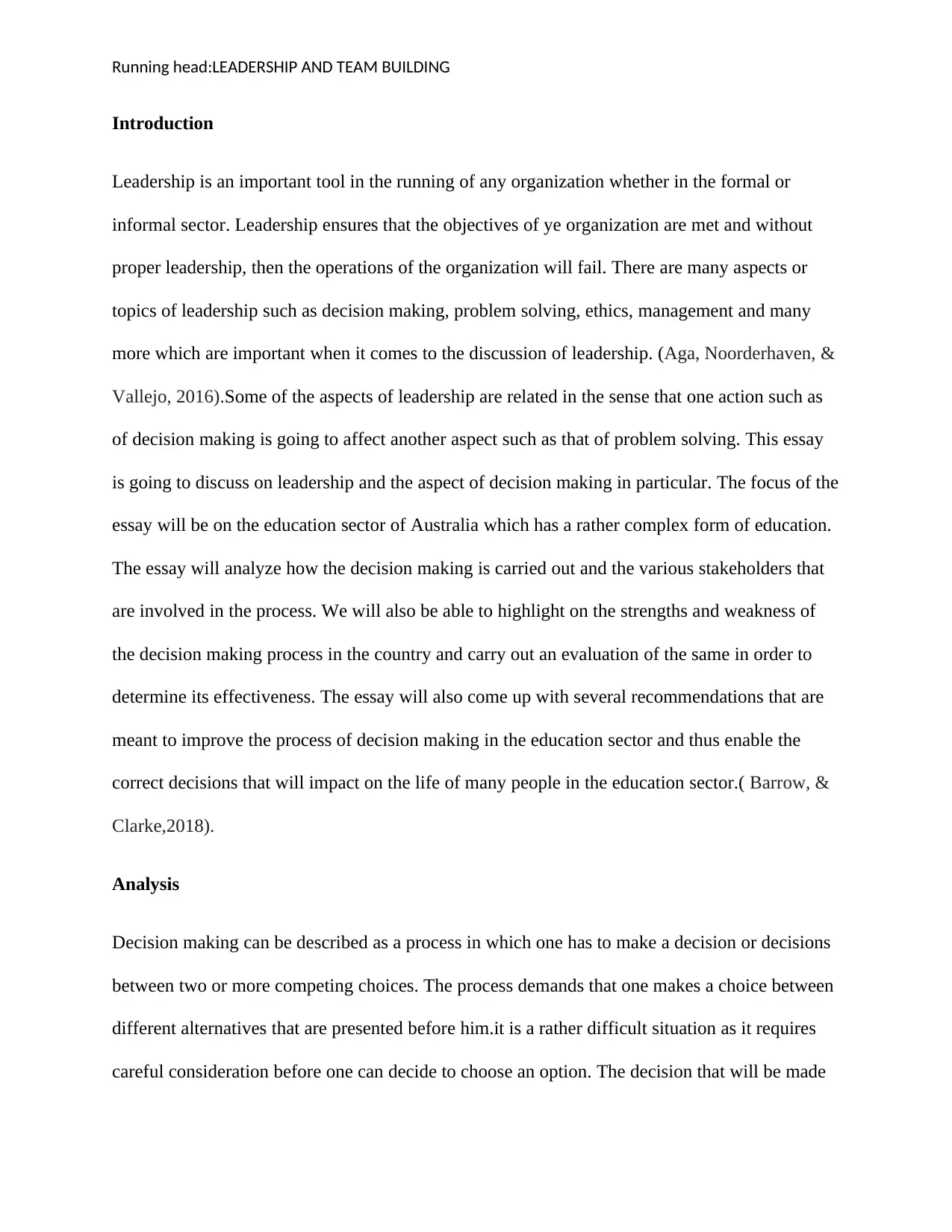
Running head:LEADERSHIP AND TEAM BUILDING
Introduction
Leadership is an important tool in the running of any organization whether in the formal or
informal sector. Leadership ensures that the objectives of ye organization are met and without
proper leadership, then the operations of the organization will fail. There are many aspects or
topics of leadership such as decision making, problem solving, ethics, management and many
more which are important when it comes to the discussion of leadership. (Aga, Noorderhaven, &
Vallejo, 2016).Some of the aspects of leadership are related in the sense that one action such as
of decision making is going to affect another aspect such as that of problem solving. This essay
is going to discuss on leadership and the aspect of decision making in particular. The focus of the
essay will be on the education sector of Australia which has a rather complex form of education.
The essay will analyze how the decision making is carried out and the various stakeholders that
are involved in the process. We will also be able to highlight on the strengths and weakness of
the decision making process in the country and carry out an evaluation of the same in order to
determine its effectiveness. The essay will also come up with several recommendations that are
meant to improve the process of decision making in the education sector and thus enable the
correct decisions that will impact on the life of many people in the education sector.( Barrow, &
Clarke,2018).
Analysis
Decision making can be described as a process in which one has to make a decision or decisions
between two or more competing choices. The process demands that one makes a choice between
different alternatives that are presented before him.it is a rather difficult situation as it requires
careful consideration before one can decide to choose an option. The decision that will be made
Introduction
Leadership is an important tool in the running of any organization whether in the formal or
informal sector. Leadership ensures that the objectives of ye organization are met and without
proper leadership, then the operations of the organization will fail. There are many aspects or
topics of leadership such as decision making, problem solving, ethics, management and many
more which are important when it comes to the discussion of leadership. (Aga, Noorderhaven, &
Vallejo, 2016).Some of the aspects of leadership are related in the sense that one action such as
of decision making is going to affect another aspect such as that of problem solving. This essay
is going to discuss on leadership and the aspect of decision making in particular. The focus of the
essay will be on the education sector of Australia which has a rather complex form of education.
The essay will analyze how the decision making is carried out and the various stakeholders that
are involved in the process. We will also be able to highlight on the strengths and weakness of
the decision making process in the country and carry out an evaluation of the same in order to
determine its effectiveness. The essay will also come up with several recommendations that are
meant to improve the process of decision making in the education sector and thus enable the
correct decisions that will impact on the life of many people in the education sector.( Barrow, &
Clarke,2018).
Analysis
Decision making can be described as a process in which one has to make a decision or decisions
between two or more competing choices. The process demands that one makes a choice between
different alternatives that are presented before him.it is a rather difficult situation as it requires
careful consideration before one can decide to choose an option. The decision that will be made
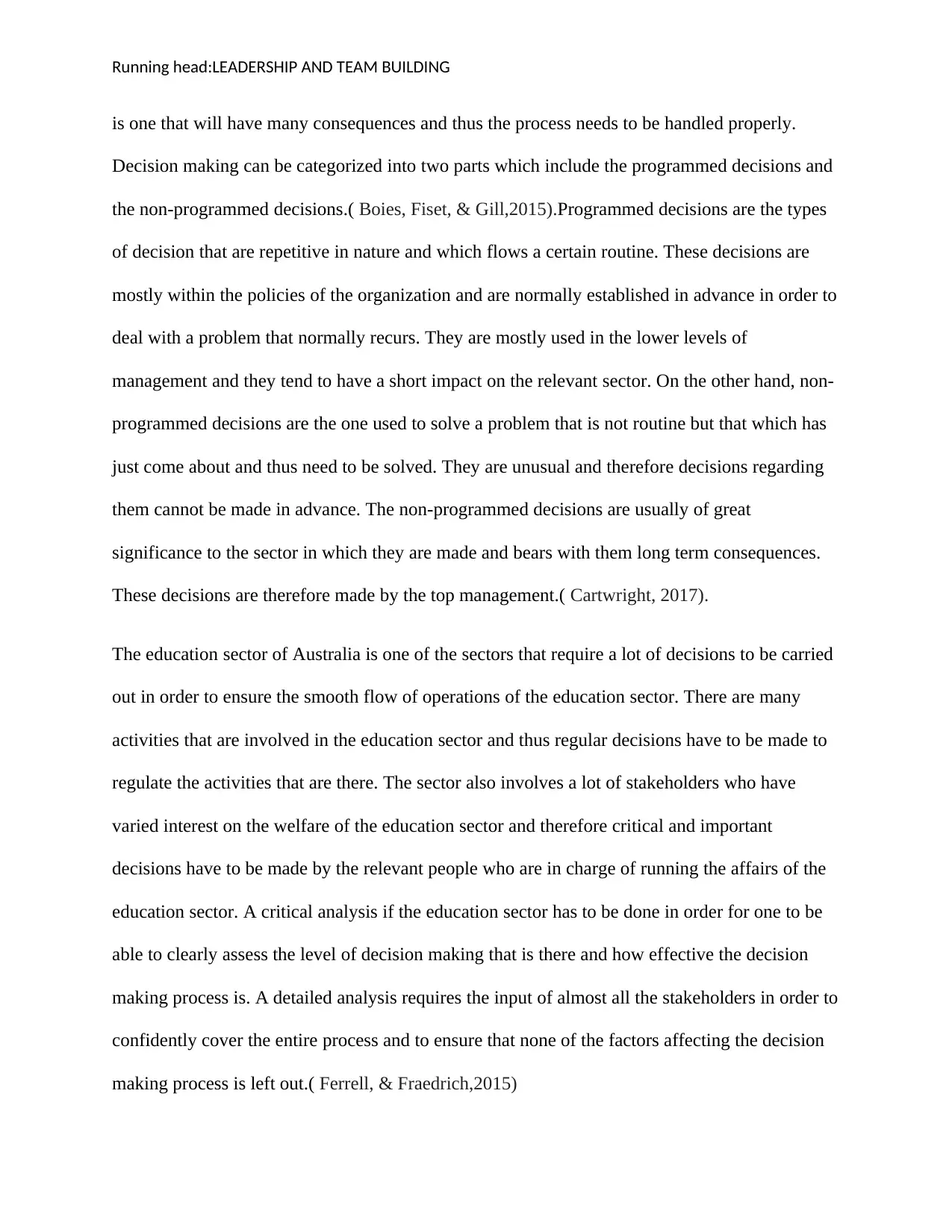
Running head:LEADERSHIP AND TEAM BUILDING
is one that will have many consequences and thus the process needs to be handled properly.
Decision making can be categorized into two parts which include the programmed decisions and
the non-programmed decisions.( Boies, Fiset, & Gill,2015).Programmed decisions are the types
of decision that are repetitive in nature and which flows a certain routine. These decisions are
mostly within the policies of the organization and are normally established in advance in order to
deal with a problem that normally recurs. They are mostly used in the lower levels of
management and they tend to have a short impact on the relevant sector. On the other hand, non-
programmed decisions are the one used to solve a problem that is not routine but that which has
just come about and thus need to be solved. They are unusual and therefore decisions regarding
them cannot be made in advance. The non-programmed decisions are usually of great
significance to the sector in which they are made and bears with them long term consequences.
These decisions are therefore made by the top management.( Cartwright, 2017).
The education sector of Australia is one of the sectors that require a lot of decisions to be carried
out in order to ensure the smooth flow of operations of the education sector. There are many
activities that are involved in the education sector and thus regular decisions have to be made to
regulate the activities that are there. The sector also involves a lot of stakeholders who have
varied interest on the welfare of the education sector and therefore critical and important
decisions have to be made by the relevant people who are in charge of running the affairs of the
education sector. A critical analysis if the education sector has to be done in order for one to be
able to clearly assess the level of decision making that is there and how effective the decision
making process is. A detailed analysis requires the input of almost all the stakeholders in order to
confidently cover the entire process and to ensure that none of the factors affecting the decision
making process is left out.( Ferrell, & Fraedrich,2015)
is one that will have many consequences and thus the process needs to be handled properly.
Decision making can be categorized into two parts which include the programmed decisions and
the non-programmed decisions.( Boies, Fiset, & Gill,2015).Programmed decisions are the types
of decision that are repetitive in nature and which flows a certain routine. These decisions are
mostly within the policies of the organization and are normally established in advance in order to
deal with a problem that normally recurs. They are mostly used in the lower levels of
management and they tend to have a short impact on the relevant sector. On the other hand, non-
programmed decisions are the one used to solve a problem that is not routine but that which has
just come about and thus need to be solved. They are unusual and therefore decisions regarding
them cannot be made in advance. The non-programmed decisions are usually of great
significance to the sector in which they are made and bears with them long term consequences.
These decisions are therefore made by the top management.( Cartwright, 2017).
The education sector of Australia is one of the sectors that require a lot of decisions to be carried
out in order to ensure the smooth flow of operations of the education sector. There are many
activities that are involved in the education sector and thus regular decisions have to be made to
regulate the activities that are there. The sector also involves a lot of stakeholders who have
varied interest on the welfare of the education sector and therefore critical and important
decisions have to be made by the relevant people who are in charge of running the affairs of the
education sector. A critical analysis if the education sector has to be done in order for one to be
able to clearly assess the level of decision making that is there and how effective the decision
making process is. A detailed analysis requires the input of almost all the stakeholders in order to
confidently cover the entire process and to ensure that none of the factors affecting the decision
making process is left out.( Ferrell, & Fraedrich,2015)
⊘ This is a preview!⊘
Do you want full access?
Subscribe today to unlock all pages.

Trusted by 1+ million students worldwide
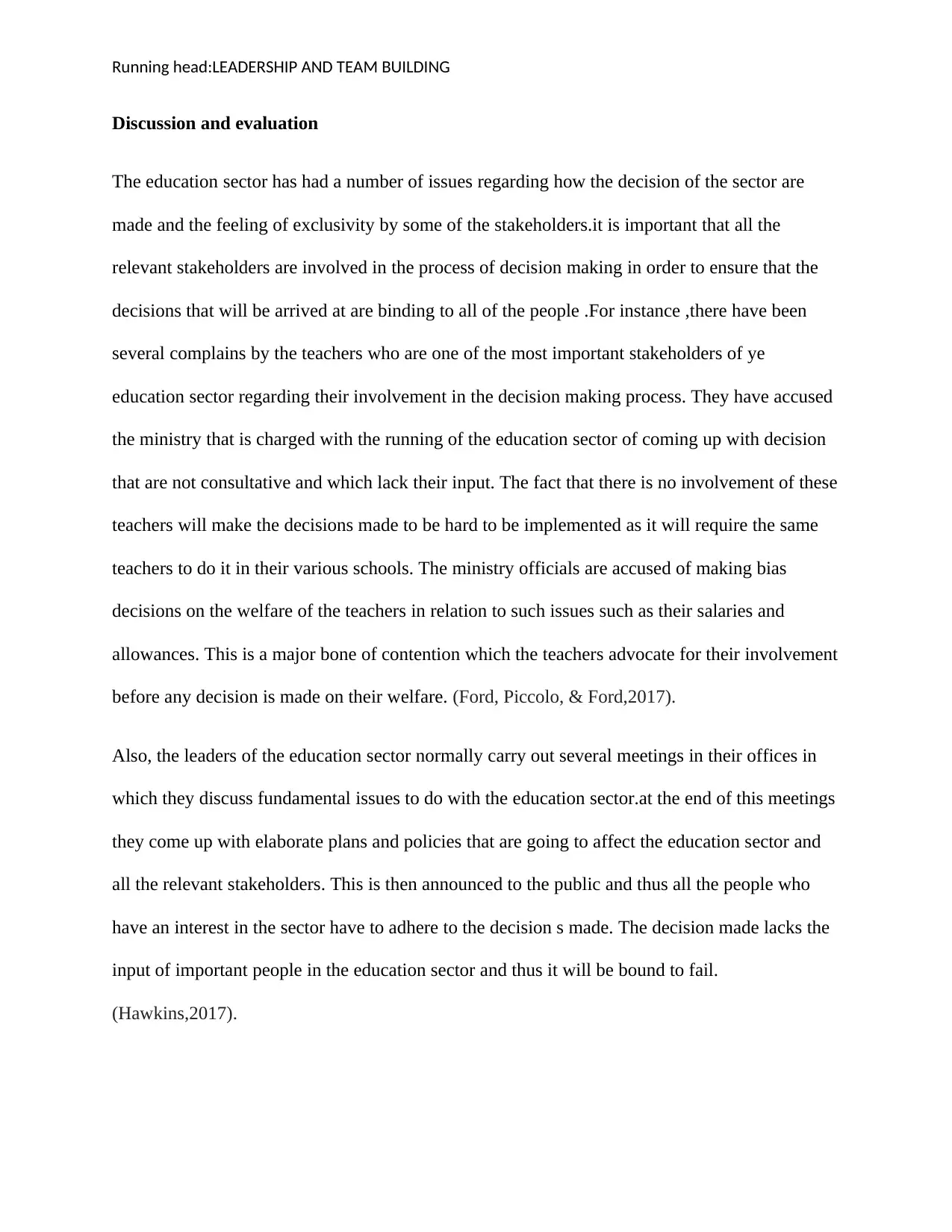
Running head:LEADERSHIP AND TEAM BUILDING
Discussion and evaluation
The education sector has had a number of issues regarding how the decision of the sector are
made and the feeling of exclusivity by some of the stakeholders.it is important that all the
relevant stakeholders are involved in the process of decision making in order to ensure that the
decisions that will be arrived at are binding to all of the people .For instance ,there have been
several complains by the teachers who are one of the most important stakeholders of ye
education sector regarding their involvement in the decision making process. They have accused
the ministry that is charged with the running of the education sector of coming up with decision
that are not consultative and which lack their input. The fact that there is no involvement of these
teachers will make the decisions made to be hard to be implemented as it will require the same
teachers to do it in their various schools. The ministry officials are accused of making bias
decisions on the welfare of the teachers in relation to such issues such as their salaries and
allowances. This is a major bone of contention which the teachers advocate for their involvement
before any decision is made on their welfare. (Ford, Piccolo, & Ford,2017).
Also, the leaders of the education sector normally carry out several meetings in their offices in
which they discuss fundamental issues to do with the education sector.at the end of this meetings
they come up with elaborate plans and policies that are going to affect the education sector and
all the relevant stakeholders. This is then announced to the public and thus all the people who
have an interest in the sector have to adhere to the decision s made. The decision made lacks the
input of important people in the education sector and thus it will be bound to fail.
(Hawkins,2017).
Discussion and evaluation
The education sector has had a number of issues regarding how the decision of the sector are
made and the feeling of exclusivity by some of the stakeholders.it is important that all the
relevant stakeholders are involved in the process of decision making in order to ensure that the
decisions that will be arrived at are binding to all of the people .For instance ,there have been
several complains by the teachers who are one of the most important stakeholders of ye
education sector regarding their involvement in the decision making process. They have accused
the ministry that is charged with the running of the education sector of coming up with decision
that are not consultative and which lack their input. The fact that there is no involvement of these
teachers will make the decisions made to be hard to be implemented as it will require the same
teachers to do it in their various schools. The ministry officials are accused of making bias
decisions on the welfare of the teachers in relation to such issues such as their salaries and
allowances. This is a major bone of contention which the teachers advocate for their involvement
before any decision is made on their welfare. (Ford, Piccolo, & Ford,2017).
Also, the leaders of the education sector normally carry out several meetings in their offices in
which they discuss fundamental issues to do with the education sector.at the end of this meetings
they come up with elaborate plans and policies that are going to affect the education sector and
all the relevant stakeholders. This is then announced to the public and thus all the people who
have an interest in the sector have to adhere to the decision s made. The decision made lacks the
input of important people in the education sector and thus it will be bound to fail.
(Hawkins,2017).
Paraphrase This Document
Need a fresh take? Get an instant paraphrase of this document with our AI Paraphraser
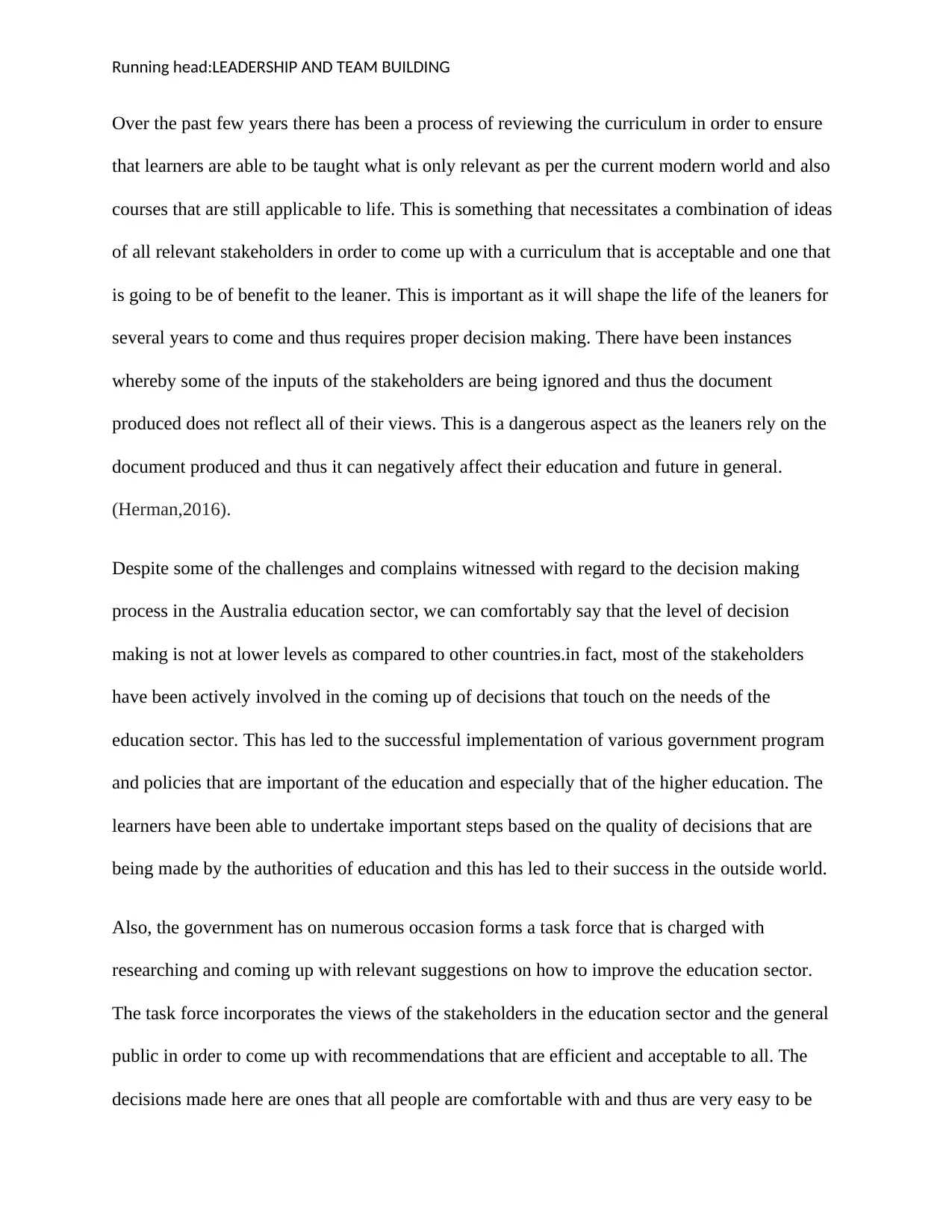
Running head:LEADERSHIP AND TEAM BUILDING
Over the past few years there has been a process of reviewing the curriculum in order to ensure
that learners are able to be taught what is only relevant as per the current modern world and also
courses that are still applicable to life. This is something that necessitates a combination of ideas
of all relevant stakeholders in order to come up with a curriculum that is acceptable and one that
is going to be of benefit to the leaner. This is important as it will shape the life of the leaners for
several years to come and thus requires proper decision making. There have been instances
whereby some of the inputs of the stakeholders are being ignored and thus the document
produced does not reflect all of their views. This is a dangerous aspect as the leaners rely on the
document produced and thus it can negatively affect their education and future in general.
(Herman,2016).
Despite some of the challenges and complains witnessed with regard to the decision making
process in the Australia education sector, we can comfortably say that the level of decision
making is not at lower levels as compared to other countries.in fact, most of the stakeholders
have been actively involved in the coming up of decisions that touch on the needs of the
education sector. This has led to the successful implementation of various government program
and policies that are important of the education and especially that of the higher education. The
learners have been able to undertake important steps based on the quality of decisions that are
being made by the authorities of education and this has led to their success in the outside world.
Also, the government has on numerous occasion forms a task force that is charged with
researching and coming up with relevant suggestions on how to improve the education sector.
The task force incorporates the views of the stakeholders in the education sector and the general
public in order to come up with recommendations that are efficient and acceptable to all. The
decisions made here are ones that all people are comfortable with and thus are very easy to be
Over the past few years there has been a process of reviewing the curriculum in order to ensure
that learners are able to be taught what is only relevant as per the current modern world and also
courses that are still applicable to life. This is something that necessitates a combination of ideas
of all relevant stakeholders in order to come up with a curriculum that is acceptable and one that
is going to be of benefit to the leaner. This is important as it will shape the life of the leaners for
several years to come and thus requires proper decision making. There have been instances
whereby some of the inputs of the stakeholders are being ignored and thus the document
produced does not reflect all of their views. This is a dangerous aspect as the leaners rely on the
document produced and thus it can negatively affect their education and future in general.
(Herman,2016).
Despite some of the challenges and complains witnessed with regard to the decision making
process in the Australia education sector, we can comfortably say that the level of decision
making is not at lower levels as compared to other countries.in fact, most of the stakeholders
have been actively involved in the coming up of decisions that touch on the needs of the
education sector. This has led to the successful implementation of various government program
and policies that are important of the education and especially that of the higher education. The
learners have been able to undertake important steps based on the quality of decisions that are
being made by the authorities of education and this has led to their success in the outside world.
Also, the government has on numerous occasion forms a task force that is charged with
researching and coming up with relevant suggestions on how to improve the education sector.
The task force incorporates the views of the stakeholders in the education sector and the general
public in order to come up with recommendations that are efficient and acceptable to all. The
decisions made here are ones that all people are comfortable with and thus are very easy to be
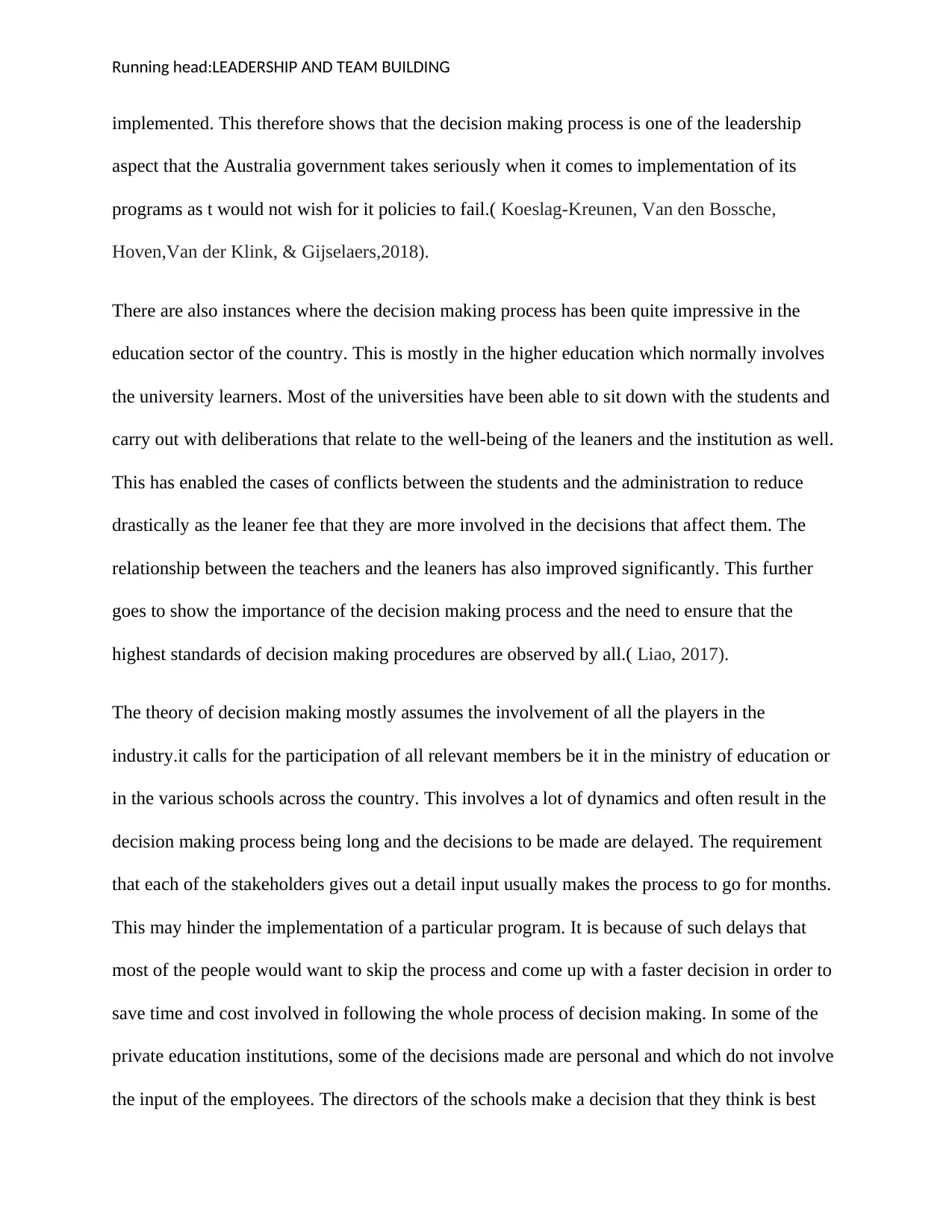
Running head:LEADERSHIP AND TEAM BUILDING
implemented. This therefore shows that the decision making process is one of the leadership
aspect that the Australia government takes seriously when it comes to implementation of its
programs as t would not wish for it policies to fail.( Koeslag-Kreunen, Van den Bossche,
Hoven,Van der Klink, & Gijselaers,2018).
There are also instances where the decision making process has been quite impressive in the
education sector of the country. This is mostly in the higher education which normally involves
the university learners. Most of the universities have been able to sit down with the students and
carry out with deliberations that relate to the well-being of the leaners and the institution as well.
This has enabled the cases of conflicts between the students and the administration to reduce
drastically as the leaner fee that they are more involved in the decisions that affect them. The
relationship between the teachers and the leaners has also improved significantly. This further
goes to show the importance of the decision making process and the need to ensure that the
highest standards of decision making procedures are observed by all.( Liao, 2017).
The theory of decision making mostly assumes the involvement of all the players in the
industry.it calls for the participation of all relevant members be it in the ministry of education or
in the various schools across the country. This involves a lot of dynamics and often result in the
decision making process being long and the decisions to be made are delayed. The requirement
that each of the stakeholders gives out a detail input usually makes the process to go for months.
This may hinder the implementation of a particular program. It is because of such delays that
most of the people would want to skip the process and come up with a faster decision in order to
save time and cost involved in following the whole process of decision making. In some of the
private education institutions, some of the decisions made are personal and which do not involve
the input of the employees. The directors of the schools make a decision that they think is best
implemented. This therefore shows that the decision making process is one of the leadership
aspect that the Australia government takes seriously when it comes to implementation of its
programs as t would not wish for it policies to fail.( Koeslag-Kreunen, Van den Bossche,
Hoven,Van der Klink, & Gijselaers,2018).
There are also instances where the decision making process has been quite impressive in the
education sector of the country. This is mostly in the higher education which normally involves
the university learners. Most of the universities have been able to sit down with the students and
carry out with deliberations that relate to the well-being of the leaners and the institution as well.
This has enabled the cases of conflicts between the students and the administration to reduce
drastically as the leaner fee that they are more involved in the decisions that affect them. The
relationship between the teachers and the leaners has also improved significantly. This further
goes to show the importance of the decision making process and the need to ensure that the
highest standards of decision making procedures are observed by all.( Liao, 2017).
The theory of decision making mostly assumes the involvement of all the players in the
industry.it calls for the participation of all relevant members be it in the ministry of education or
in the various schools across the country. This involves a lot of dynamics and often result in the
decision making process being long and the decisions to be made are delayed. The requirement
that each of the stakeholders gives out a detail input usually makes the process to go for months.
This may hinder the implementation of a particular program. It is because of such delays that
most of the people would want to skip the process and come up with a faster decision in order to
save time and cost involved in following the whole process of decision making. In some of the
private education institutions, some of the decisions made are personal and which do not involve
the input of the employees. The directors of the schools make a decision that they think is best
⊘ This is a preview!⊘
Do you want full access?
Subscribe today to unlock all pages.

Trusted by 1+ million students worldwide
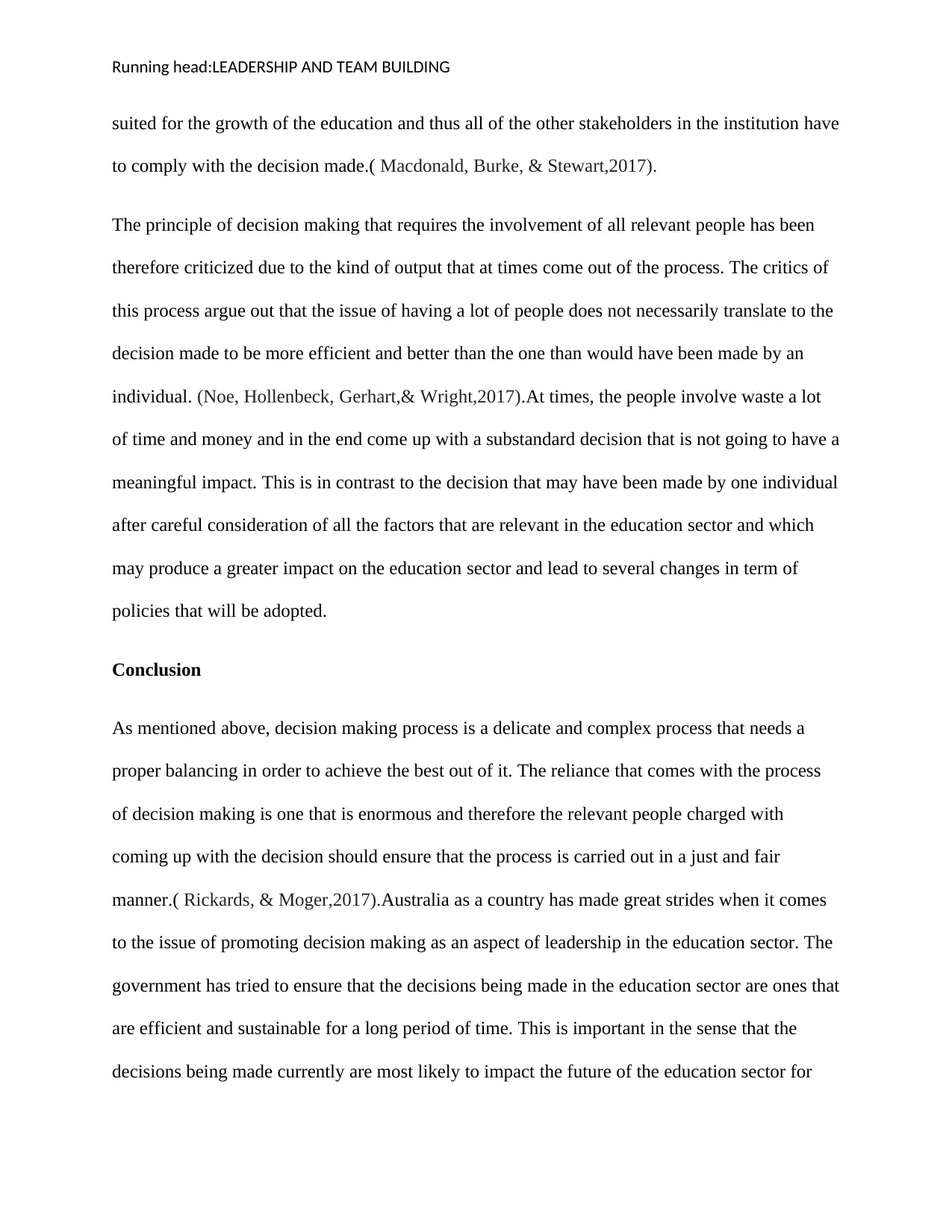
Running head:LEADERSHIP AND TEAM BUILDING
suited for the growth of the education and thus all of the other stakeholders in the institution have
to comply with the decision made.( Macdonald, Burke, & Stewart,2017).
The principle of decision making that requires the involvement of all relevant people has been
therefore criticized due to the kind of output that at times come out of the process. The critics of
this process argue out that the issue of having a lot of people does not necessarily translate to the
decision made to be more efficient and better than the one than would have been made by an
individual. (Noe, Hollenbeck, Gerhart,& Wright,2017).At times, the people involve waste a lot
of time and money and in the end come up with a substandard decision that is not going to have a
meaningful impact. This is in contrast to the decision that may have been made by one individual
after careful consideration of all the factors that are relevant in the education sector and which
may produce a greater impact on the education sector and lead to several changes in term of
policies that will be adopted.
Conclusion
As mentioned above, decision making process is a delicate and complex process that needs a
proper balancing in order to achieve the best out of it. The reliance that comes with the process
of decision making is one that is enormous and therefore the relevant people charged with
coming up with the decision should ensure that the process is carried out in a just and fair
manner.( Rickards, & Moger,2017).Australia as a country has made great strides when it comes
to the issue of promoting decision making as an aspect of leadership in the education sector. The
government has tried to ensure that the decisions being made in the education sector are ones that
are efficient and sustainable for a long period of time. This is important in the sense that the
decisions being made currently are most likely to impact the future of the education sector for
suited for the growth of the education and thus all of the other stakeholders in the institution have
to comply with the decision made.( Macdonald, Burke, & Stewart,2017).
The principle of decision making that requires the involvement of all relevant people has been
therefore criticized due to the kind of output that at times come out of the process. The critics of
this process argue out that the issue of having a lot of people does not necessarily translate to the
decision made to be more efficient and better than the one than would have been made by an
individual. (Noe, Hollenbeck, Gerhart,& Wright,2017).At times, the people involve waste a lot
of time and money and in the end come up with a substandard decision that is not going to have a
meaningful impact. This is in contrast to the decision that may have been made by one individual
after careful consideration of all the factors that are relevant in the education sector and which
may produce a greater impact on the education sector and lead to several changes in term of
policies that will be adopted.
Conclusion
As mentioned above, decision making process is a delicate and complex process that needs a
proper balancing in order to achieve the best out of it. The reliance that comes with the process
of decision making is one that is enormous and therefore the relevant people charged with
coming up with the decision should ensure that the process is carried out in a just and fair
manner.( Rickards, & Moger,2017).Australia as a country has made great strides when it comes
to the issue of promoting decision making as an aspect of leadership in the education sector. The
government has tried to ensure that the decisions being made in the education sector are ones that
are efficient and sustainable for a long period of time. This is important in the sense that the
decisions being made currently are most likely to impact the future of the education sector for
Paraphrase This Document
Need a fresh take? Get an instant paraphrase of this document with our AI Paraphraser
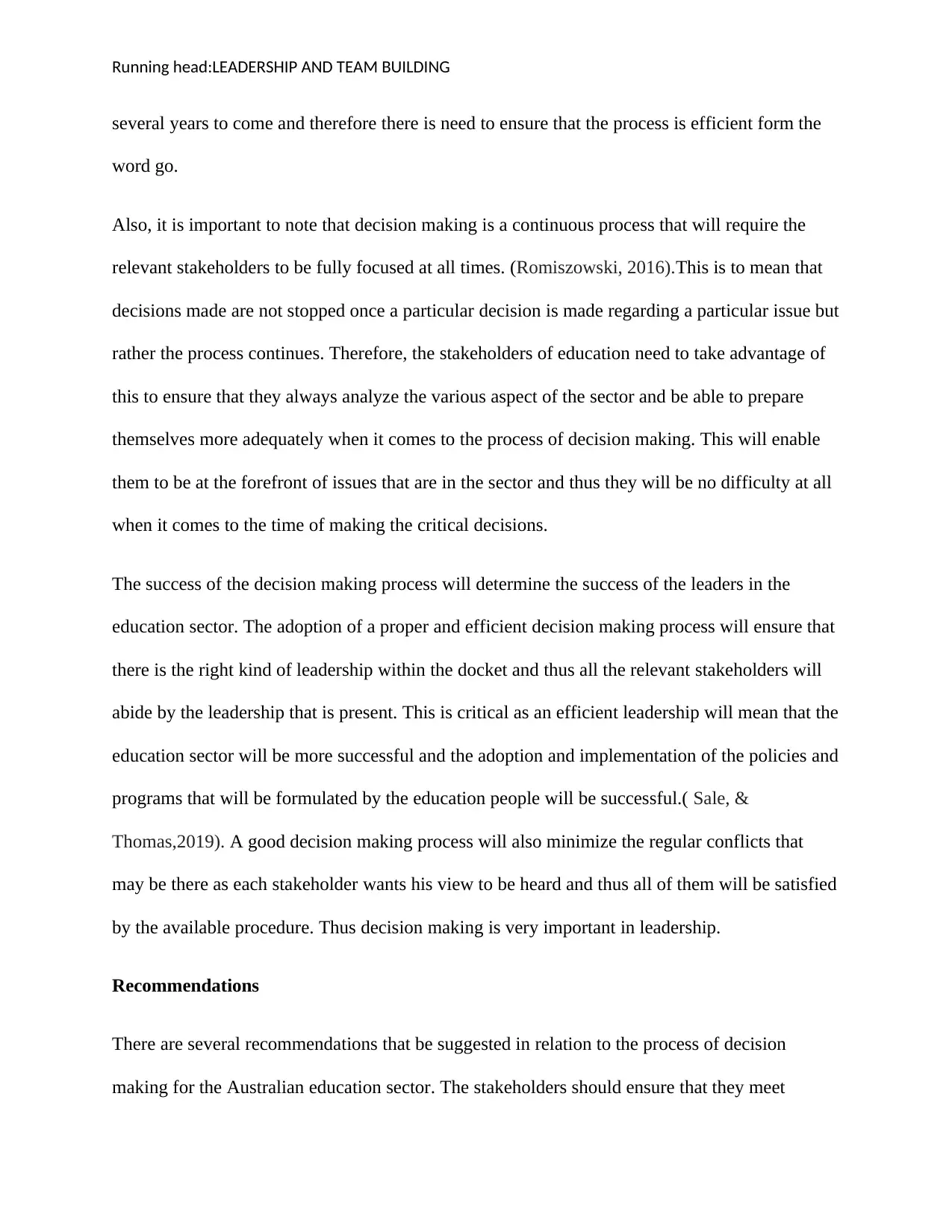
Running head:LEADERSHIP AND TEAM BUILDING
several years to come and therefore there is need to ensure that the process is efficient form the
word go.
Also, it is important to note that decision making is a continuous process that will require the
relevant stakeholders to be fully focused at all times. (Romiszowski, 2016).This is to mean that
decisions made are not stopped once a particular decision is made regarding a particular issue but
rather the process continues. Therefore, the stakeholders of education need to take advantage of
this to ensure that they always analyze the various aspect of the sector and be able to prepare
themselves more adequately when it comes to the process of decision making. This will enable
them to be at the forefront of issues that are in the sector and thus they will be no difficulty at all
when it comes to the time of making the critical decisions.
The success of the decision making process will determine the success of the leaders in the
education sector. The adoption of a proper and efficient decision making process will ensure that
there is the right kind of leadership within the docket and thus all the relevant stakeholders will
abide by the leadership that is present. This is critical as an efficient leadership will mean that the
education sector will be more successful and the adoption and implementation of the policies and
programs that will be formulated by the education people will be successful.( Sale, &
Thomas,2019). A good decision making process will also minimize the regular conflicts that
may be there as each stakeholder wants his view to be heard and thus all of them will be satisfied
by the available procedure. Thus decision making is very important in leadership.
Recommendations
There are several recommendations that be suggested in relation to the process of decision
making for the Australian education sector. The stakeholders should ensure that they meet
several years to come and therefore there is need to ensure that the process is efficient form the
word go.
Also, it is important to note that decision making is a continuous process that will require the
relevant stakeholders to be fully focused at all times. (Romiszowski, 2016).This is to mean that
decisions made are not stopped once a particular decision is made regarding a particular issue but
rather the process continues. Therefore, the stakeholders of education need to take advantage of
this to ensure that they always analyze the various aspect of the sector and be able to prepare
themselves more adequately when it comes to the process of decision making. This will enable
them to be at the forefront of issues that are in the sector and thus they will be no difficulty at all
when it comes to the time of making the critical decisions.
The success of the decision making process will determine the success of the leaders in the
education sector. The adoption of a proper and efficient decision making process will ensure that
there is the right kind of leadership within the docket and thus all the relevant stakeholders will
abide by the leadership that is present. This is critical as an efficient leadership will mean that the
education sector will be more successful and the adoption and implementation of the policies and
programs that will be formulated by the education people will be successful.( Sale, &
Thomas,2019). A good decision making process will also minimize the regular conflicts that
may be there as each stakeholder wants his view to be heard and thus all of them will be satisfied
by the available procedure. Thus decision making is very important in leadership.
Recommendations
There are several recommendations that be suggested in relation to the process of decision
making for the Australian education sector. The stakeholders should ensure that they meet
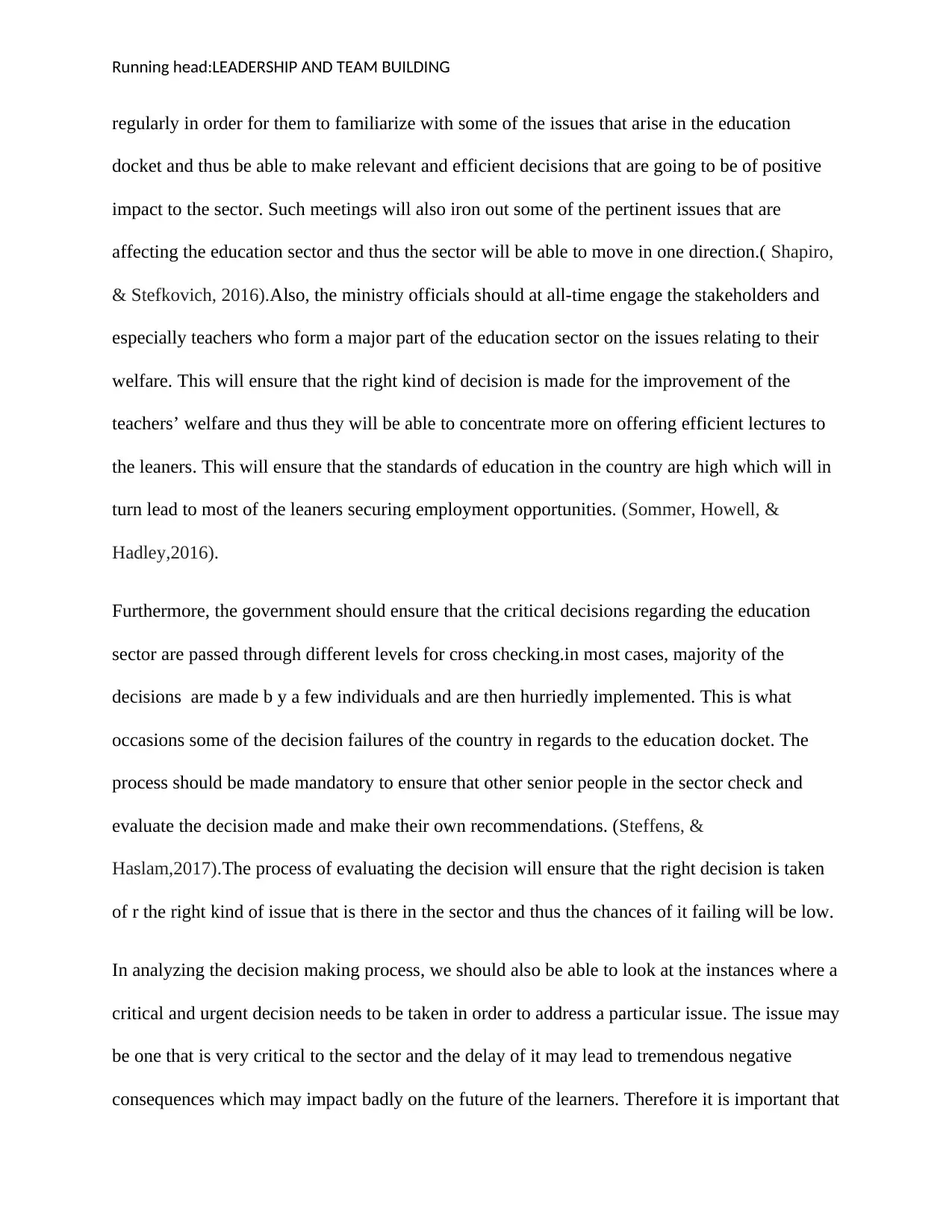
Running head:LEADERSHIP AND TEAM BUILDING
regularly in order for them to familiarize with some of the issues that arise in the education
docket and thus be able to make relevant and efficient decisions that are going to be of positive
impact to the sector. Such meetings will also iron out some of the pertinent issues that are
affecting the education sector and thus the sector will be able to move in one direction.( Shapiro,
& Stefkovich, 2016).Also, the ministry officials should at all-time engage the stakeholders and
especially teachers who form a major part of the education sector on the issues relating to their
welfare. This will ensure that the right kind of decision is made for the improvement of the
teachers’ welfare and thus they will be able to concentrate more on offering efficient lectures to
the leaners. This will ensure that the standards of education in the country are high which will in
turn lead to most of the leaners securing employment opportunities. (Sommer, Howell, &
Hadley,2016).
Furthermore, the government should ensure that the critical decisions regarding the education
sector are passed through different levels for cross checking.in most cases, majority of the
decisions are made b y a few individuals and are then hurriedly implemented. This is what
occasions some of the decision failures of the country in regards to the education docket. The
process should be made mandatory to ensure that other senior people in the sector check and
evaluate the decision made and make their own recommendations. (Steffens, &
Haslam,2017).The process of evaluating the decision will ensure that the right decision is taken
of r the right kind of issue that is there in the sector and thus the chances of it failing will be low.
In analyzing the decision making process, we should also be able to look at the instances where a
critical and urgent decision needs to be taken in order to address a particular issue. The issue may
be one that is very critical to the sector and the delay of it may lead to tremendous negative
consequences which may impact badly on the future of the learners. Therefore it is important that
regularly in order for them to familiarize with some of the issues that arise in the education
docket and thus be able to make relevant and efficient decisions that are going to be of positive
impact to the sector. Such meetings will also iron out some of the pertinent issues that are
affecting the education sector and thus the sector will be able to move in one direction.( Shapiro,
& Stefkovich, 2016).Also, the ministry officials should at all-time engage the stakeholders and
especially teachers who form a major part of the education sector on the issues relating to their
welfare. This will ensure that the right kind of decision is made for the improvement of the
teachers’ welfare and thus they will be able to concentrate more on offering efficient lectures to
the leaners. This will ensure that the standards of education in the country are high which will in
turn lead to most of the leaners securing employment opportunities. (Sommer, Howell, &
Hadley,2016).
Furthermore, the government should ensure that the critical decisions regarding the education
sector are passed through different levels for cross checking.in most cases, majority of the
decisions are made b y a few individuals and are then hurriedly implemented. This is what
occasions some of the decision failures of the country in regards to the education docket. The
process should be made mandatory to ensure that other senior people in the sector check and
evaluate the decision made and make their own recommendations. (Steffens, &
Haslam,2017).The process of evaluating the decision will ensure that the right decision is taken
of r the right kind of issue that is there in the sector and thus the chances of it failing will be low.
In analyzing the decision making process, we should also be able to look at the instances where a
critical and urgent decision needs to be taken in order to address a particular issue. The issue may
be one that is very critical to the sector and the delay of it may lead to tremendous negative
consequences which may impact badly on the future of the learners. Therefore it is important that
⊘ This is a preview!⊘
Do you want full access?
Subscribe today to unlock all pages.

Trusted by 1+ million students worldwide
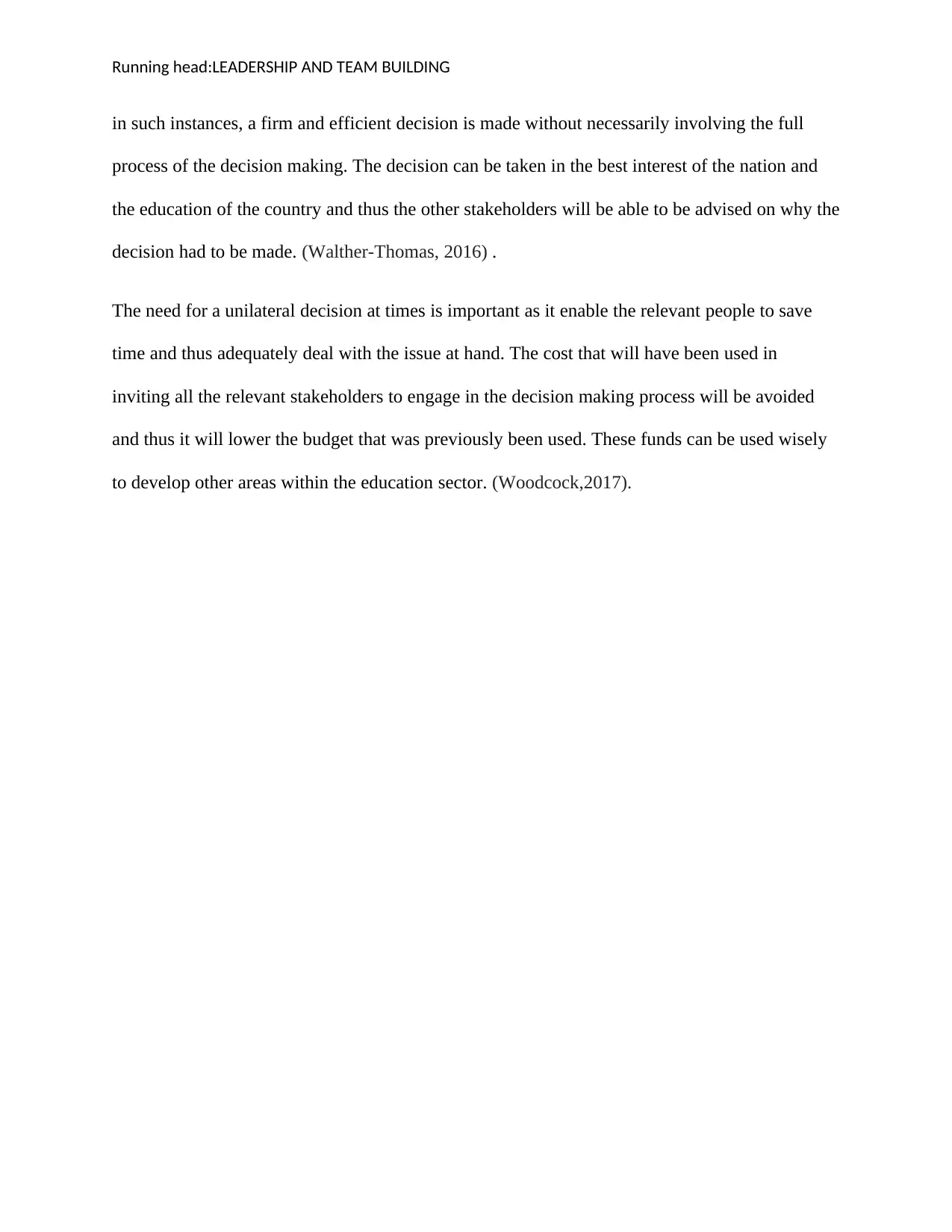
Running head:LEADERSHIP AND TEAM BUILDING
in such instances, a firm and efficient decision is made without necessarily involving the full
process of the decision making. The decision can be taken in the best interest of the nation and
the education of the country and thus the other stakeholders will be able to be advised on why the
decision had to be made. (Walther-Thomas, 2016) .
The need for a unilateral decision at times is important as it enable the relevant people to save
time and thus adequately deal with the issue at hand. The cost that will have been used in
inviting all the relevant stakeholders to engage in the decision making process will be avoided
and thus it will lower the budget that was previously been used. These funds can be used wisely
to develop other areas within the education sector. (Woodcock,2017).
in such instances, a firm and efficient decision is made without necessarily involving the full
process of the decision making. The decision can be taken in the best interest of the nation and
the education of the country and thus the other stakeholders will be able to be advised on why the
decision had to be made. (Walther-Thomas, 2016) .
The need for a unilateral decision at times is important as it enable the relevant people to save
time and thus adequately deal with the issue at hand. The cost that will have been used in
inviting all the relevant stakeholders to engage in the decision making process will be avoided
and thus it will lower the budget that was previously been used. These funds can be used wisely
to develop other areas within the education sector. (Woodcock,2017).
Paraphrase This Document
Need a fresh take? Get an instant paraphrase of this document with our AI Paraphraser
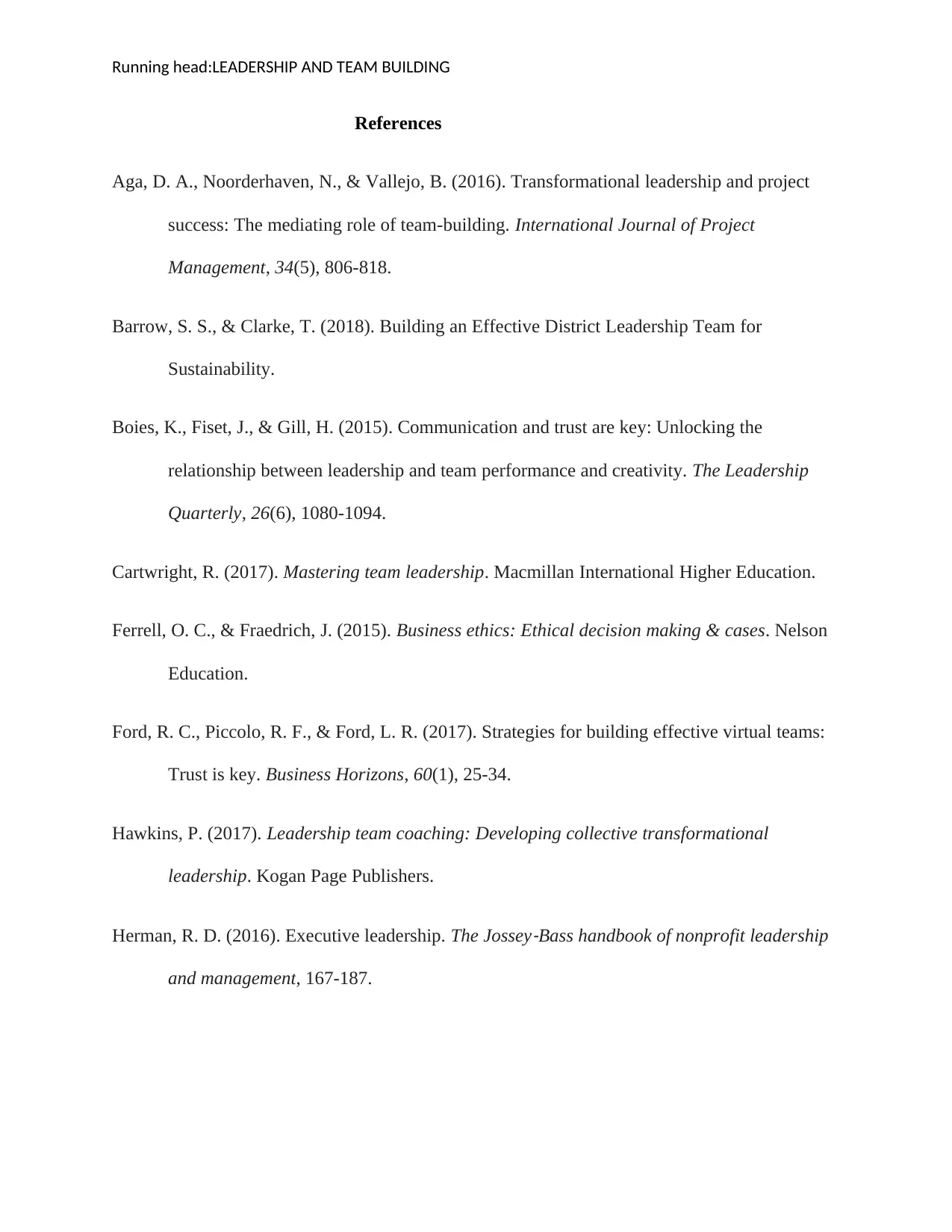
Running head:LEADERSHIP AND TEAM BUILDING
References
Aga, D. A., Noorderhaven, N., & Vallejo, B. (2016). Transformational leadership and project
success: The mediating role of team-building. International Journal of Project
Management, 34(5), 806-818.
Barrow, S. S., & Clarke, T. (2018). Building an Effective District Leadership Team for
Sustainability.
Boies, K., Fiset, J., & Gill, H. (2015). Communication and trust are key: Unlocking the
relationship between leadership and team performance and creativity. The Leadership
Quarterly, 26(6), 1080-1094.
Cartwright, R. (2017). Mastering team leadership. Macmillan International Higher Education.
Ferrell, O. C., & Fraedrich, J. (2015). Business ethics: Ethical decision making & cases. Nelson
Education.
Ford, R. C., Piccolo, R. F., & Ford, L. R. (2017). Strategies for building effective virtual teams:
Trust is key. Business Horizons, 60(1), 25-34.
Hawkins, P. (2017). Leadership team coaching: Developing collective transformational
leadership. Kogan Page Publishers.
Herman, R. D. (2016). Executive leadership. The Jossey
‐Bass handbook of nonprofit leadership
and management, 167-187.
References
Aga, D. A., Noorderhaven, N., & Vallejo, B. (2016). Transformational leadership and project
success: The mediating role of team-building. International Journal of Project
Management, 34(5), 806-818.
Barrow, S. S., & Clarke, T. (2018). Building an Effective District Leadership Team for
Sustainability.
Boies, K., Fiset, J., & Gill, H. (2015). Communication and trust are key: Unlocking the
relationship between leadership and team performance and creativity. The Leadership
Quarterly, 26(6), 1080-1094.
Cartwright, R. (2017). Mastering team leadership. Macmillan International Higher Education.
Ferrell, O. C., & Fraedrich, J. (2015). Business ethics: Ethical decision making & cases. Nelson
Education.
Ford, R. C., Piccolo, R. F., & Ford, L. R. (2017). Strategies for building effective virtual teams:
Trust is key. Business Horizons, 60(1), 25-34.
Hawkins, P. (2017). Leadership team coaching: Developing collective transformational
leadership. Kogan Page Publishers.
Herman, R. D. (2016). Executive leadership. The Jossey
‐Bass handbook of nonprofit leadership
and management, 167-187.
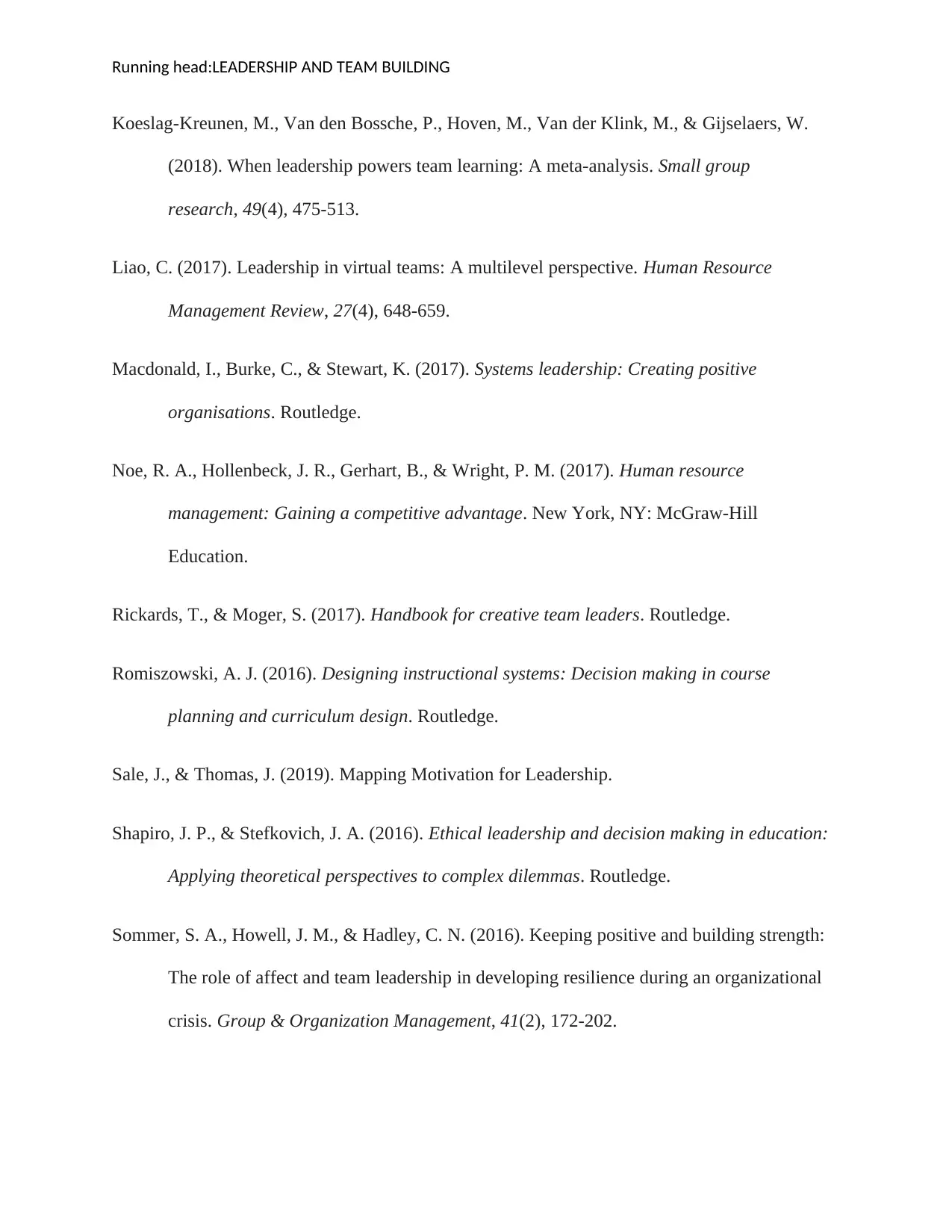
Running head:LEADERSHIP AND TEAM BUILDING
Koeslag-Kreunen, M., Van den Bossche, P., Hoven, M., Van der Klink, M., & Gijselaers, W.
(2018). When leadership powers team learning: A meta-analysis. Small group
research, 49(4), 475-513.
Liao, C. (2017). Leadership in virtual teams: A multilevel perspective. Human Resource
Management Review, 27(4), 648-659.
Macdonald, I., Burke, C., & Stewart, K. (2017). Systems leadership: Creating positive
organisations. Routledge.
Noe, R. A., Hollenbeck, J. R., Gerhart, B., & Wright, P. M. (2017). Human resource
management: Gaining a competitive advantage. New York, NY: McGraw-Hill
Education.
Rickards, T., & Moger, S. (2017). Handbook for creative team leaders. Routledge.
Romiszowski, A. J. (2016). Designing instructional systems: Decision making in course
planning and curriculum design. Routledge.
Sale, J., & Thomas, J. (2019). Mapping Motivation for Leadership.
Shapiro, J. P., & Stefkovich, J. A. (2016). Ethical leadership and decision making in education:
Applying theoretical perspectives to complex dilemmas. Routledge.
Sommer, S. A., Howell, J. M., & Hadley, C. N. (2016). Keeping positive and building strength:
The role of affect and team leadership in developing resilience during an organizational
crisis. Group & Organization Management, 41(2), 172-202.
Koeslag-Kreunen, M., Van den Bossche, P., Hoven, M., Van der Klink, M., & Gijselaers, W.
(2018). When leadership powers team learning: A meta-analysis. Small group
research, 49(4), 475-513.
Liao, C. (2017). Leadership in virtual teams: A multilevel perspective. Human Resource
Management Review, 27(4), 648-659.
Macdonald, I., Burke, C., & Stewart, K. (2017). Systems leadership: Creating positive
organisations. Routledge.
Noe, R. A., Hollenbeck, J. R., Gerhart, B., & Wright, P. M. (2017). Human resource
management: Gaining a competitive advantage. New York, NY: McGraw-Hill
Education.
Rickards, T., & Moger, S. (2017). Handbook for creative team leaders. Routledge.
Romiszowski, A. J. (2016). Designing instructional systems: Decision making in course
planning and curriculum design. Routledge.
Sale, J., & Thomas, J. (2019). Mapping Motivation for Leadership.
Shapiro, J. P., & Stefkovich, J. A. (2016). Ethical leadership and decision making in education:
Applying theoretical perspectives to complex dilemmas. Routledge.
Sommer, S. A., Howell, J. M., & Hadley, C. N. (2016). Keeping positive and building strength:
The role of affect and team leadership in developing resilience during an organizational
crisis. Group & Organization Management, 41(2), 172-202.
⊘ This is a preview!⊘
Do you want full access?
Subscribe today to unlock all pages.

Trusted by 1+ million students worldwide
1 out of 13
Related Documents
Your All-in-One AI-Powered Toolkit for Academic Success.
+13062052269
info@desklib.com
Available 24*7 on WhatsApp / Email
![[object Object]](/_next/static/media/star-bottom.7253800d.svg)
Unlock your academic potential
Copyright © 2020–2025 A2Z Services. All Rights Reserved. Developed and managed by ZUCOL.




